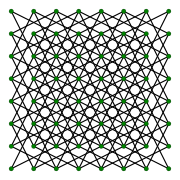Knight's graph
| Knight's graph | |
|---|---|
|
8x8 Knight's graph | |
| Vertices | nm |
| Edges | 4mn-6(m+n)+8 |
| Girth | 4 (if n≥3, m≥ 5) |
In graph theory, a knight's graph, or a knight's tour graph, is a graph that represents all legal moves of the knight chess piece on a chessboard where each vertex represents a square on a chessboard and each edge is a legal move.
More specifically, an  knight's tour graph is a knight's tour graph of an
knight's tour graph is a knight's tour graph of an  chessboard.[1]
chessboard.[1]
For a  knight's tour graph the total number of vertices is simply
knight's tour graph the total number of vertices is simply  . For a
. For a  knight's tour graph the total number of vertices is simply
knight's tour graph the total number of vertices is simply  and the total number of edges is
and the total number of edges is  .[2]
.[2]
A Hamiltonian path on the knight's tour graph is a knight's tour.[1] Schwenk's theorem characterizes the sizes of chessboard for which a knight's tour exist.[3]
References
- ↑ 1.0 1.1 Averbach, Bonnie; Chein, Orin (1980), Problem Solving Through Recreational Mathematics, Dover, p. 195, ISBN 9780486131740.
- ↑ "Sloane's A033996 ", The On-Line Encyclopedia of Integer Sequences. OEIS Foundation.
- ↑ Watkins, John J. (2012), Across the Board: The Mathematics of Chessboard Problems. Paradoxes, perplexities, and mathematical conundrums for the serious head scratcher, Princeton University Press, p. 44, ISBN 9780691154985.
